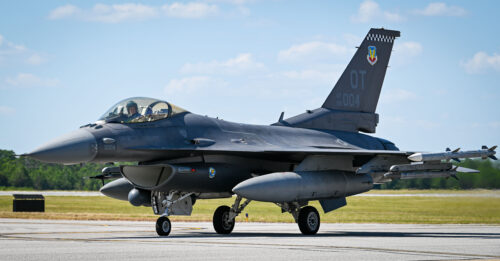The U.S. Air Force has successfully flown an F-16 fighter jet equipped with a new electronic warfare system designed to counter advanced threats on the modern battlefield. The landmark first flight took place last month at Eglin Air Force Base in Florida, marking a significant milestone for the Integrated Viper Electronic Warfare Suite (IVEWS) program.

IVEWS provides the F-16 with advanced electronic warfare capabilities, including digital radar warning and active jamming capabilities, enabling it to detect, identify, locate, and neutralize potential threats. This sophisticated suite of technologies elevates the F-16 to a “fourth generation plus” status, ensuring its relevance and effectiveness against modern adversaries. The system represents a leap forward in the F-16’s electronic warfare capabilities, bolstering its readiness to face increasingly complex aerial threats.
At the heart of IVEWS lies Northrop Grumman’s cutting-edge ultra-wideband electronic warfare system architecture, which offers numerous benefits, including cost advantages, shorter upgrade cycles, and streamlined logistics. This modular design approach allows for greater flexibility and adaptability, ensuring the system can keep pace with evolving threats. IVEWS comprises a next-generation digital radar warning receiver, a high-performance processor specifically engineered for electronic warfare applications, and powerful transmitters paired with antennas meticulously optimized for the F-16’s size, weight, and power constraints.
Crucially, IVEWS seamlessly integrates with the F-16’s AN/APG-83 Scalable Agile Beam Radar (SABR) Active Electronically Scanned Array (AESA) radar. This tight-knit interoperability guarantees unimpeded operation, without compromising the aircraft’s defensive capabilities or targeting prowess. The system was rigorously tested during Exercise Northern Lightning, where it performed flawlessly amidst a dense and challenging electromagnetic spectrum environment, demonstrating its ability to function effectively in real-world combat scenarios.
Lt. Col. Stephen Graham, the F-16 Electronic Warfare Test Director who skillfully piloted the inaugural flight, underscored the seamless integration of IVEWS with the F-16, stating that it elevates the aircraft to new heights of capability. “The success of this flight is a testament to the entire team working on this program,” Graham remarked, emphasizing the collaborative spirit that drove the program’s success. He acknowledged the remarkable efforts of the engineers, pilots, and technicians from various defense contractors who played pivotal roles in bringing IVEWS to fruition.
Lt. Col. Joseph Gagnon, commander of the 85th Test and Evaluation Squadron, highlighted the broader implications of the IVEWS program, emphasizing its adaptability and potential for application on other aircraft platforms. “This technology can be implemented on almost any airframe,” he noted, underscoring its versatility and potential to enhance the survivability of a wide range of aircraft. This adaptability makes IVEWS a force multiplier, extending its benefits beyond the F-16 to encompass a diverse array of platforms.
The IVEWS program also holds significant potential for international partners, offering them access to advanced electronic warfare capabilities that can enhance the survivability of their F-16 fleets. This collaborative approach fosters interoperability and strengthens partnerships, ensuring that allied forces are equipped to face shared threats in an increasingly complex global security environment.. The successful first flight of the IVEWS-equipped F-16 marks a pivotal advancement in modernizing the F-16 fleet, ensuring its enduring relevance and effectiveness in the face of evolving threats.
For more information, hit the Source below
Sounds like 88-004 on the F-16C as it’s many years of service attests to.